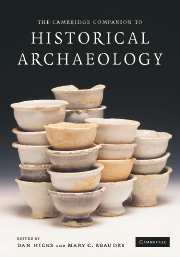Book contents
- Frontmatter
- Dedication
- Contents
- List of figures
- List of tables
- List of contributors
- Acknowledgements
- List of abbreviations
- 1 Introduction: the place of historical archaeology
- PART I ARCHAEOLOGY AND HISTORY
- PART II KEY THEMES IN HISTORICAL ARCHAEOLOGY
- 5 Historical archaeology and colonialism
- 6 Urban historical archaeology
- 7 Archaeology, heritage and the recent and contemporary past
- 8 Marxism and capitalism in historical archaeology
- 9 Historical archaeology and industrialisation
- 10 Historical maritime archaeology
- PART III HISTORICAL ARCHAEOLOGY AND MATERIAL CULTURE
- PART IV HISTORICAL ARCHAEOLOGY AND LANDSCAPES
- PART V HISTORICAL ARCHAEOLOGY AND BUILDINGS
- References
- Index
7 - Archaeology, heritage and the recent and contemporary past
from PART II - KEY THEMES IN HISTORICAL ARCHAEOLOGY
Published online by Cambridge University Press: 05 July 2015
- Frontmatter
- Dedication
- Contents
- List of figures
- List of tables
- List of contributors
- Acknowledgements
- List of abbreviations
- 1 Introduction: the place of historical archaeology
- PART I ARCHAEOLOGY AND HISTORY
- PART II KEY THEMES IN HISTORICAL ARCHAEOLOGY
- 5 Historical archaeology and colonialism
- 6 Urban historical archaeology
- 7 Archaeology, heritage and the recent and contemporary past
- 8 Marxism and capitalism in historical archaeology
- 9 Historical archaeology and industrialisation
- 10 Historical maritime archaeology
- PART III HISTORICAL ARCHAEOLOGY AND MATERIAL CULTURE
- PART IV HISTORICAL ARCHAEOLOGY AND LANDSCAPES
- PART V HISTORICAL ARCHAEOLOGY AND BUILDINGS
- References
- Index
Summary
For the first time, those concerned for the historic environment are taking decisions not only about the management and interpretation of ancient and historic monuments, buildings and landscapes, but also about those of the recent and ‘contemporary past’ (Buchli and Lucas 2001c); about those places that we ourselves have created, or whose creation is remembered, and whose form and character we continue to influence in our everyday lives and social practices. Furthermore, such decisions are being influenced by a wider range of people and groups than at any time since conservation practice first gained legislative support, in the late nineteenth century in England's case and the early twentieth century in the United States. Decisions are now the result of dialogue and participation involving not only national organisations and government at local, regional and national levels, but also – significantly – local communities. As Roger Thomas (2004: 191) has said, ‘;today, people are less ready to accept the “authorized” view of the archaeological past, preferring to choose for themselves what kind of past they wish to believe in.’
This is especially the case where the past is close, and involves people's direct experience and memory – a past in other words to which people have strong attachment. In Silicon Valley, northern California, for example, the present has very quickly become the past: here memory, place and progress are closely interwoven in a complex social and cultural–technological landscape (Finn 2001). In Detroit, sense of place and the city's heritage is recognised in various ways, not least through its music: the origins of Motown in the 1960s, and techno in the 1980s and 90s, are both reflections of the city's mean streets and industrial ambiance; the distinctive rhythms a result – some say – of the clattering mechanical beat of its assembly lines (Connell and Gibson 2003: 99). Both examples demonstrate the diversity of recent and contemporary material culture and the importance of place for existing communities. They each demonstrate also the close proximity of past and present, and the challenge of this proximity for researchers, curators and local communities.
- Type
- Chapter
- Information
- The Cambridge Companion to Historical Archaeology , pp. 104 - 122Publisher: Cambridge University PressPrint publication year: 2006
- 7
- Cited by



